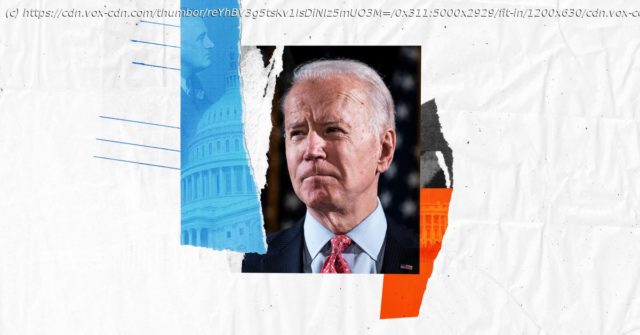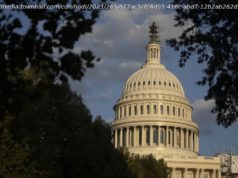This is the future Joe Biden wants. Can he break from his past to get there?
But can he break from his past to get there? When I asked Symone Sanders, a senior adviser to Joe Biden’s 2020 campaign, what the former vice president’s plan for his first 100 days in office was, her answer was blunt. “Wouldn’t everybody like to know?” Sanders was being coy — in fact, she had just finished walking me through Biden’s “Build Back Better” agenda, an umbrella term that the campaign has been using for policies meant to aid the economic recovery from the Covid-19 crisis. But the answer is yes: Everybody would like to know what Joe Biden would do were he to take office. And the formal platform on which he’s running, and his five-decade record as a public servant, offer markedly different predictions as to what a Biden presidency would look like. Biden is attempting to take office amid a world-historic crisis, which has already claimed more American lives than World War I, Korea, and Vietnam combined and has produced the highest unemployment rates since the Great Depression. By May, advisers were telling New York magazine’s Gabriel Debenedetti that Biden wanted an “FDR-sized” administration. There are aspects of Biden’s policy agenda that rise to this level of ambition. To tackle Covid-19, he’s promised nationwide testing, a 100,000-person Public Health Jobs Corps, hazard pay for essential workers, massive vaccine stockpiles produced ahead of approval for the speediest deployment, and much more. His economic recovery plan would pay health insurance costs for newly unemployed people, offer middle-class parents and caretakers $8,000 a year for child or long-term care support, spend $700 billion on manufacturing and R&D to expand jobs in those sectors, and make it easier to organize unions. His climate plan features $2 trillion in investments in clean energy and a clean electricity standard mandating that electricity production in the US not produce any carbon by the year 2035. But there is a tension between this ambition and the man himself. For all of the avowed boldness of an agenda shaped by Covid-19, the man pitching it remains… Joe Biden. He is a creature of the establishment, a product of a Democratic Party built for the (relative) boom times of the 1980s and ’90s, a Senate from a less polarized era, and an Obama administration that believed it could transcend Washington (it could not). When you talk to his campaign, you can see glimpses of that Biden. Yes, he’s proposing these multitrillion-dollar plans — but his advisers insist he’s a deficit hawk at heart. “The vice president has said from the beginning of the campaign that he wants to show how he’s going to pay for all of the long-term costs of the investments that he makes,” senior policy adviser Jake Sullivan, who also served as a key policy staffer to Hillary Clinton in 2016 and was Biden’s national security adviser in 2013-14, says. His campaign also seemed to back away from an earlier hint that Biden might support blowing up the Senate filibuster if the Republicans abuse it to block his agenda. Biden “has not supported the elimination of the filibuster,” Sanders told me. “I don’t think anyone should read his comments as saying he supports that.” Ted Kaufman, who took Biden’s Delaware Senate seat in 2009 and has been a loyal aide to the former vice president for decades, remembers that the last time Biden entered the White House, Senate Republicans chose to block absolutely everything the Obama-Biden administration tried. My question, I told Kaufman, was what would Biden do if Senate Republicans do the exact same thing again? We shouldn’t be too despondent, he said. Biden worked out deals with Senate Republican leader Mitch McConnell, like the 2011 budget deal involving $1.2 trillion in brutal, across-the-board spending cuts. He’s willing to do the hard work to figure out “what is something everyone can agree on?” Kaufman sought to reassure me. There are two visions of a Biden presidency. One involves sweeping investments in clean energy, new jobs, and a fast recovery from the Covid-19 pandemic and recession. The other involves McConnell forcing Biden into brutal, humiliating budget deals that usher in austerity and strangle the recovery in the crib. Therein lies the fundamental tension in Biden’s candidacy: To enact his promised agenda, President Biden will have to be bolder than Sen. Biden and Vice President Biden ever were. Biden’s four-point plan to “Build Back Better” Joe Biden’s self-styling as the next FDR is, in some ways, natural. Both men ran for president amid a historic economic collapse that demanded massive government intervention to ameliorate the suffering of hundreds of millions of people. As Vox’s Ella Nilsen has reported, some Biden advisers make the comparison explicitly, with economic adviser Jared Bernstein telling her, “Much like FDR faced a structural crisis of economic insecurity, we’re at a similar place. The vice president recognizes that the extent of market failure here is not something you can fix with a Band-Aid and that structural reforms are necessary.” So what does Biden’s version of the New Deal, forged by the Covid-19 crisis, look like? The best encapsulation comes out of the candidate’s “Build Back Better” plan. Ben Harris, who served as Biden’s chief economist from 2014 to 2017 and is currently a top economic adviser to the campaign, describes the plan as a road map for “recovery” over the medium to long run, not near-run stimulus relief. “Relief is designed to plug the holes immediately, and recovery is designed to build a base for growth for the next decade,” Harris told me. “If you look at Build Back Better combined, it lays out his agenda for growth over the first term and beyond.” Biden’s aides point to the plan as proof that Biden is not the tepid moderate his critics sometimes paint him as. “One of the things that’s differentiated him in the primary and has confused people is they say, ‘He’s moderate.’ No,” Kaufman says. All four central planks are out now, and the campaign expects them to remain the top policy themes, and the top priorities of a Biden presidency. In dollar terms, the biggest component of the plan is the $2 trillion commitment to investments in green energy over just four years. This is also, perhaps surprisingly, the part of Build Back Better with the longest history on the Biden campaign. He originally proposed an investment of $1.7 trillion over a decade in June 2019, well before any primaries had been held. The amount has been upped by $300 billion, but the rough scale of the commitment has been there for well over a year. The actual spending will include subsidies creating jobs working on electric vehicles, infrastructure projects “from roads and bridges to green spaces and water systems to electricity grids and universal broadband,” and providing “every American city with 100,000 or more residents with high-quality, zero-emissions public transportation options.” The size of the investment is exceptionally large; for comparison’s sake, the coverage provisions of Obamacare had a gross cost, before taxes and penalties, of $938 billion over 10 years. Even adjusting for inflation and a larger economy, Biden’s $2 trillion plan is significantly bigger, especially if it’s spent over just four years rather than a decade. Perhaps even more important than the dollar amount is the clean energy standard embedded in the plan, which will mandate that all of America’s electricity come from carbon-free sources (whether solar, wind, hydro, nuclear, biomass, etc.) by 2035. The plan’s ambition and sweep earned widespread acclaim from environmental activists. The Sunrise Movement, which gave Biden an “F-” grade for his climate policies during the primaries, put out a statement praising the plan, tweeting that it’s “a major step forward, & parts are more ambitious than what Bernie Sanders ran on in 2016, or Jay Inslee championed in 2020.” Julian Brave NoiseCat, director of Green New Deal strategy for Data for Progress, called the plan “a Green New Deal in all but name.” The second-largest plank is Biden’s 10-year, $775 billion plan for caregiving. The program includes pledges of universal pre-K for all 3- and 4-year-olds, a tax credit paying up to half of child care costs up to a maximum of $8,000 per child for families making under $125,000 a year, and subsidies ensuring that “no family earning below 1.5 times the median income in their state will have to pay more than 7% of their income for quality care,” with the typical family “pay[ing] no more than $45 per week.” He’s also proposing a large tax credit for employers that build on-site child care centers, and other programs meant to increase the supply of child care services, not just subsidies for it. Next up is the investment of $700 billion over a decade that Biden has promised in “made in America” goods. The plan, called “Made in All of America” in recognition of its goal of reaching distressed rural, Rust Belt, Southern, and other neglected regions of the country, harks back to Biden’s focus on the manufacturing economy during his time as vice president.






